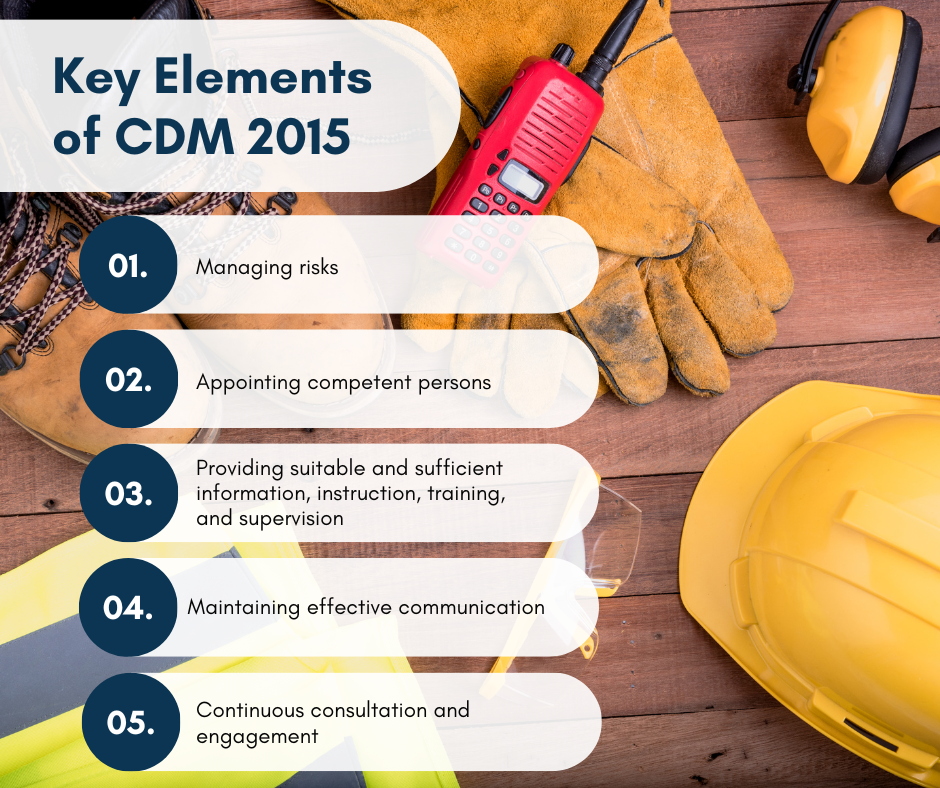The Construction (Design and Management) Regulations 2015 aims to improve workplace health and safety by enhancing planning, cooperation and coordination, risk management, communication, consultation, and more.
It is a legal requirement that every construction project must meet the CDM 2015 regulations.
What are the CDM Regulations 2015?
 Effective from 6th April 2015, replacing The Construction (Design and Management) Regulations 2007, CDM 2015 covers the management of health, safety and welfare on construction projects. It applies to all construction work within Great Britain and its territorial seas.
Effective from 6th April 2015, replacing The Construction (Design and Management) Regulations 2007, CDM 2015 covers the management of health, safety and welfare on construction projects. It applies to all construction work within Great Britain and its territorial seas.
Incorporating the key elements, the HSE says is necessary to ensure health and safety on construction sites, such as:
- Managing risks by applying preventative controls
- Appointing competent persons within the organisation at the right time to ensure sufficient planning. For example, provision or receipt of pre-construction information i.e., asbestos survey, service plans or structural drawings.
- Making sure suitable and sufficient information, instruction, training, and supervision is provided to all persons working on or visiting a construction project.
- Maintaining effective communication between all appointed duty holders to coordinate the project.
- Continuous consultation and engagement with workers to promote and develop a good health and safety culture.
The regulations specify when a project is notifiable to the HSE, Office for Rail and Road or Office for Nuclear Regulation:
- if the construction work is scheduled to last longer than 30 working days and have more than 20 workers working simultaneously at any point in the project.
- or exceed 500 person days.
This notification document is called an F10 notice and must be clearly displayed in the site office and updated when necessary. It must include information such as planned start date and duration of the project along with names and addresses of all contractors on site.
Under Regulation 12, the principal contractor must also draw up (or make arrangements for the drawing up of) a Construction Phase Plan (CPP).
This must set out the health and safety arrangements and site rules, including any specific measures concerning work falling within one or more categories set out in Schedule 3, such as work with the risk of exposure to chemical or biological substances.
The principal designer must assist in the creation of the CPP by providing the principal contractor with all relevant information they hold.
 The regulations also set the standard and requirements onsite for elements such as welfare facilities. These should include:
The regulations also set the standard and requirements onsite for elements such as welfare facilities. These should include:
- separate toilet facilities provided for men and women, unless they are in a separate lockable room
- facilities for rest
- access to drinking water
- changing facilities if required – where a person must wear special clothing and cannot for reasons of health or propriety be expected to change elsewhere
What are the duties under CDM Regulations 2015?
Regulation 2(1) define and outline the roles and responsibilities of the various duty holders for construction projects. Organisations and individuals can have the responsibility of one or more duty holder for a project. These duty holders are:
Client & Domestic Client
They could be commercial, defined as “any person for whom a project is carried out”, or domestic – similarly defined as the client, however construction work “is not done in connection with a business” this could be on their home or that of a family member.
Regardless of the size of the project, the client has contractual control in which they must appoint the principal contractor and principal designer (in writing) whilst ensuring resources are sufficient by determining the money and time.
They also have a duty to provide pre-construction information such as existing service drawings and details of any known hazards such as asbestos.
Principal Designer & Designer
 The principal designer has overall control of the pre-construction phase and is required where there is more than one contractor at any time.
The principal designer has overall control of the pre-construction phase and is required where there is more than one contractor at any time.
The work of the principal designer is important as it involves coordinating the work in the project team to ensure that significant and foreseeable risks are managed throughout the design process. They must liaise with the principal contractor to establish the construction phase plan.
There may be more than one designer on a project and are defined as anyone who prepares or modifies information for any part of the construction project.
All have a duty to ensure any changes made to designs consider the general principles of prevention along with any pre-construction information.
Principal Contractor & Contractor
The principal contractor fulfils the role of safety and health coordinator for the project execution stage and as such plays an important role to manage the risks and provide strong leadership.
Ultimately having duty to plan, manage and monitor the construction phase and coordinate health and safety matters. The contractor must liaise with the principal contractor throughout the project to ensure these risks are appropriately managed and must also plan and monitor the work under their control.
Worker
It is the principal contractor’s duty to consult anyone working on a construction project (or their representatives) on matters relating to their health, safety and welfare. Workers therefore have a duty to ensure their health and safety and that of others who may be affected by their activities, reporting hazards and cooperating with site requirements.
For further detailed information on CDM 2015 including the roles and responsibilities of duty holders, you can download L153 for free on the HSE’s website.
How can WA Management help?
Our experienced and competent CDM Consultants are certified under the SSIP scheme, and are available to explain the roles and responsibilities under CDM 2015 and advise and assist on all matters of CDM 2015 compliance.

Asbestos Awareness, Manual Handling & Working at Height training courses are essential tools in protecting the health and safety of your employees. Make sure you don’t miss out on our 10% off deal on these courses, available until the end of October. Simply enter the code ‘construct10’ at checkout to save!
Read more Consultant’s blogs here.
To keep up to date with the latest health & safety news and advice, follow us on social media:
